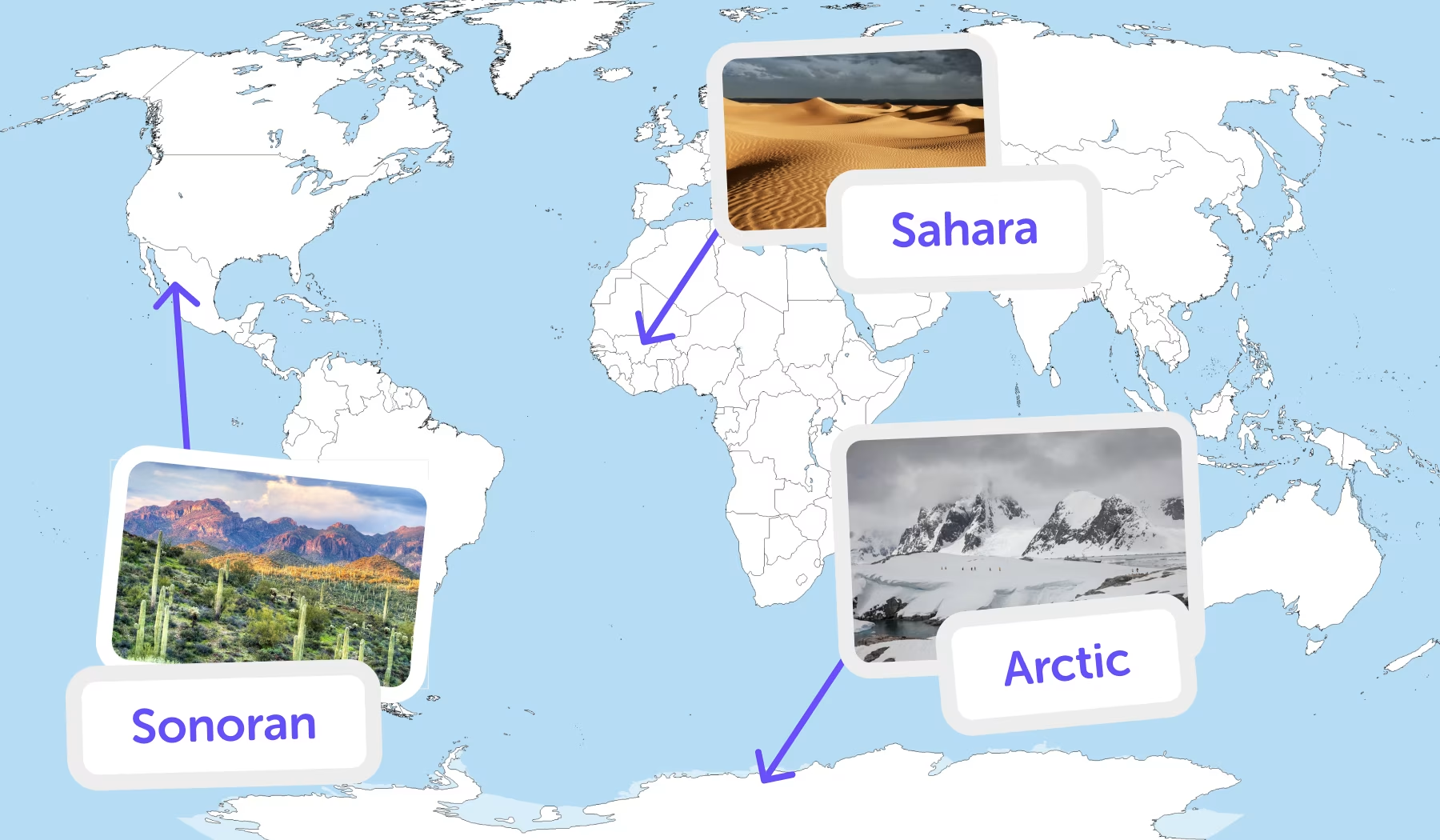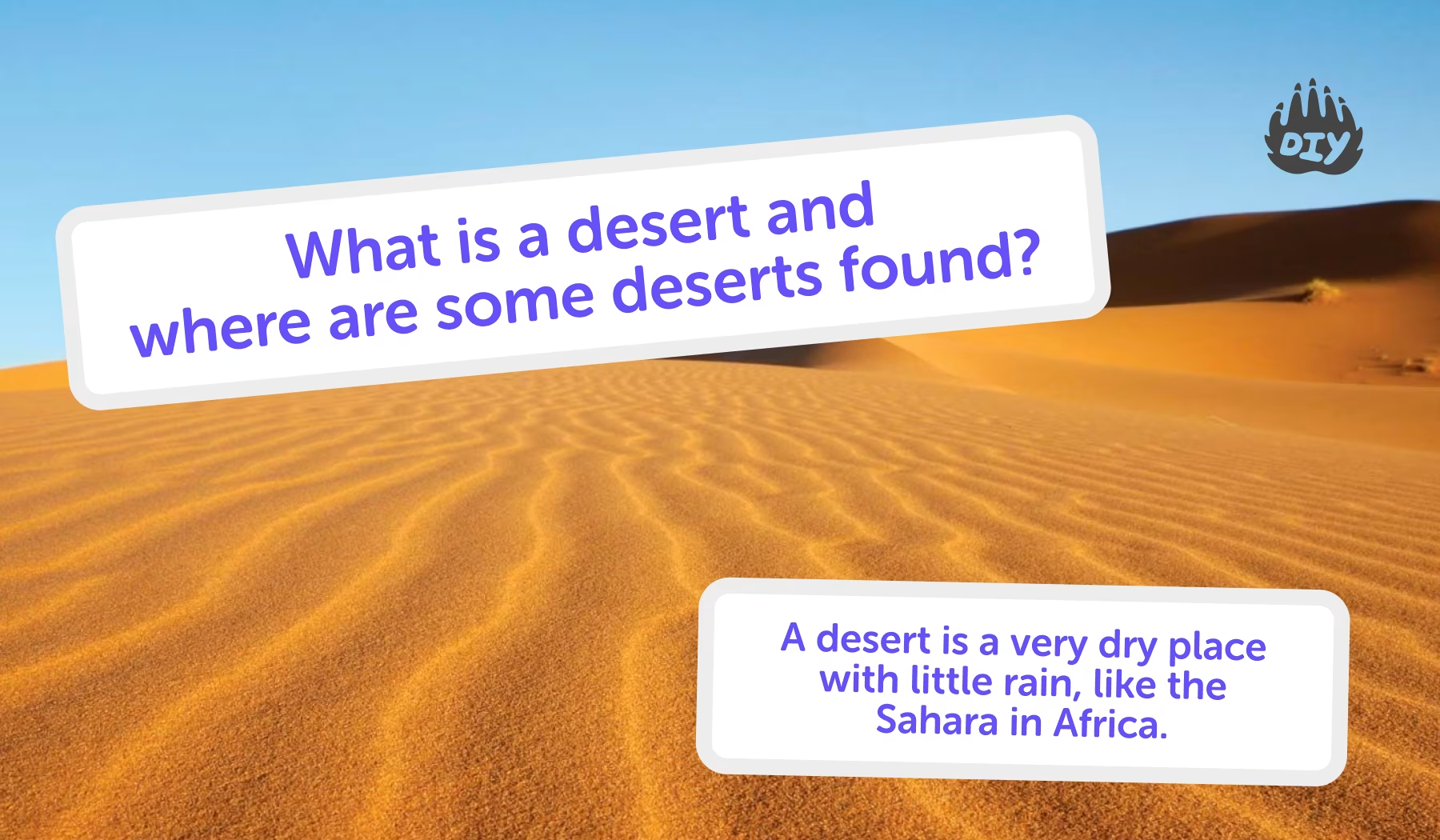When kids picture a desert, they often imagine endless sand dunes, blazing sun, and camels. But deserts are more than that; they’re unique ecosystems found all over the world.
Why Kids Learn About Deserts
Geography homework often asks: What is a desert? Where are some deserts found? Answering these questions helps kids see how climate, plants, and animals adapt to extreme conditions.
For clear, step-by-step explanations, the AI Homework Helper is a safe way for children to explore deserts without confusing or unsafe web searches.
What Is a Desert?
A desert is not just about heat, it’s about dryness.
Deserts receive less than 10 inches (25 cm) of rain per year.
Some deserts are hot (like the Sahara).
Some deserts are cold (like Antarctica).
So the key feature of a desert is low rainfall, not just high temperature.

Types of Deserts
Hot Deserts
High temperatures during the day, cool at night.
Examples: Sahara (Africa), Arabian (Middle East), Sonoran (North America).
Cold Deserts
Dry but freezing much of the year.
Examples: Gobi (Asia), Great Basin (North America), Antarctica (polar desert).
👉 Ask the DIY.org homework helper tool: “What’s the difference between a hot desert and a cold desert?”
Famous Deserts Around the World
Desert | Location | Type | Key Facts | Wildlife / Cultural Notes |
|---|---|---|---|---|
Sahara Desert | Africa | Hot desert | Largest hot desert in the world; spans 11 countries | Camels, fennec foxes; desert nomads |
Gobi Desert | Asia (Mongolia & China) | Cold desert | Rocky terrain; big temperature swings | Snow leopards; wild Bactrian camels |
Kalahari Desert | Africa | Semi-desert | More rainfall than the Sahara | Meerkats, lions, zebras |
Arabian Desert | Middle East (Saudi Arabia, Oman, Yemen) | Hot desert | Rich underground oil reserves | — |
Great Victoria Desert | Australia | Hot desert | Largest desert in Australia | Unique plants; Aboriginal heritage |
How Plants and Animals Survive in Deserts
Deserts look empty, but they’re full of life:
Plants: Cacti store water, acacias grow deep roots.
Animals: Camels store fat in humps, fennec foxes have big ears to cool down, insects hide underground during heat.
Humans: Desert people adapt with special clothing, housing, and traditions.
Everyday Connections for Kids
Deserts affect daily life in surprising ways:
Many spices (like cumin) come from desert regions.
Solar panels work especially well in deserts.
Desert minerals (like copper and gold) are used in electronics.
Fun Facts About Deserts
Antarctica is the world’s largest desert!
Some desert plants can live without rain for years.
Desert sands shift so much that maps can change over time.
The Atacama Desert in Chile is one of the driest places on Earth parts haven’t seen rain for centuries.
👉 Ask the AI Homework Helper: “Is Antarctica really a desert?”
Tips for Parents Helping With Geography Homework
Use maps and globes: Show deserts across continents.
Make it relatable: Compare desert dryness to how quickly clothes dry in the sun.
Encourage questions: Let the Homework Helper explain tricky points like why deserts are cold at night.
Link to current events: Talk about climate change and desertification.
Frequently Asked Questions about Deserts
What makes a desert a desert?
Very little rainfall less than 10 inches per year.
Are all deserts hot?
No, some are cold like the Gobi or Antarctica.
Which is the largest desert?
Antarctica is a cold polar desert.
Which is the largest hot desert?
The Sahara in Africa.
What animals live in deserts?
Camels, lizards, snakes, foxes, owls, and insects.
Can people live in deserts?
Yes, many groups adapt with special clothing, houses, and farming methods.
The Bottom Line
Deserts may look empty, but they’re full of unique plants, animals, and cultures that adapt to extreme dryness. From the hot sands of the Sahara to the icy stretches of Antarctica, deserts remind us how diverse Earth really is.
For kids, learning about deserts answers homework questions and sparks curiosity. And with the DIY.org homework helper tool, they can safely explore facts, ask questions, and quiz themselves.



